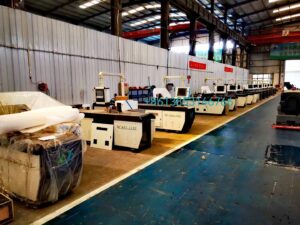
In metal processing, copper-aluminum busbar are widely used due to their excellent conductivity and processability. However, during the bending process, the elastic properties of copper-aluminum strips often lead to rebound, which causes bending angle deviations and affects product quality and production efficiency. So, how can this problem be addressed? Below are several effective solutions:
1. Application of Electronic Bending Dies
Electronic bending dies are high-precision, high-stability bending tools that use advanced control systems to regulate the contact pressure between the die and the workpiece, reducing the bending angle inaccuracies caused by rebound. This technology can precisely control the mechanical changes during the busbar bending process, ensuring that the bending angle of the copper-aluminum busbars after bending matches the design specifications.
2. Reducing Busbar Bending Collision Speed
Excessive collision speed during the bending process is a major factor leading to severe rebound. To minimize rebound, the bending machine’s speed can be adjusted to achieve a slower transition during the collision process. Slowing down the speed not only reduces the impact force but also allows the material to maintain better plasticity during bending, thereby reducing the amount of rebound.
3. Using Elastic Compensation Technology
Elastic compensation technology is an optimization approach designed for the rebound characteristics of materials. It calculates the rebound amount of the copper-aluminum busbar and applies an appropriate pre-bend force during the busbar bending process to compensate for the angular errors caused by elastic rebound. This technology effectively improves the bending accuracy, ensuring that the final product meets the design requirements.
4. Choosing the Right Bending Dies and Tools
To reduce the rebound effect in copper-aluminum busbars, selecting the right bending dies is crucial. Using dies with smaller radii and those suited to the properties of copper-aluminum materials can significantly reduce the material’s rebound, thus improving bending accuracy. The selection of die materials is also important; materials with moderate hardness and high wear resistance should be chosen to enhance the durability of the dies and the quality of the busbar bending process.
5. Optimizing Bending Process Parameters
In addition to equipment and dies, adjusting the bending process parameters can also effectively reduce the rebound problem. This includes fine-tuning the bending angle, bending speed, and pressure according to the actual properties of the copper-aluminum strip to find the optimal bending conditions. This optimization helps achieve precise bending results.
Conclusion
Rebound during the bending process of copper-aluminum busbar is a common challenge in metal processing. However, by appropriately using electronic bending dies, reducing bending collision speeds, applying elastic compensation technology, choosing the right dies, and optimizing process parameters, this problem can be effectively addressed, leading to improved bending accuracy and production efficiency. As technology continues to progress, future solutions in this field will become even more refined, further promoting innovation and development in copper-aluminum busbar bending processes.
